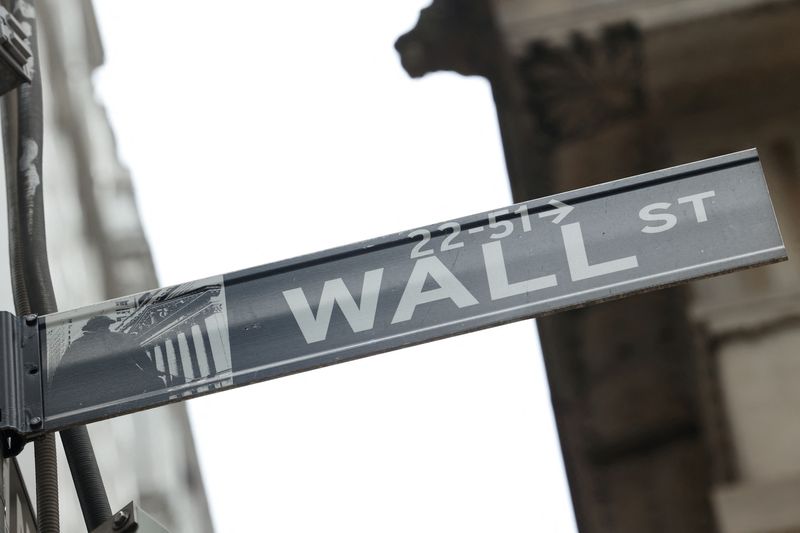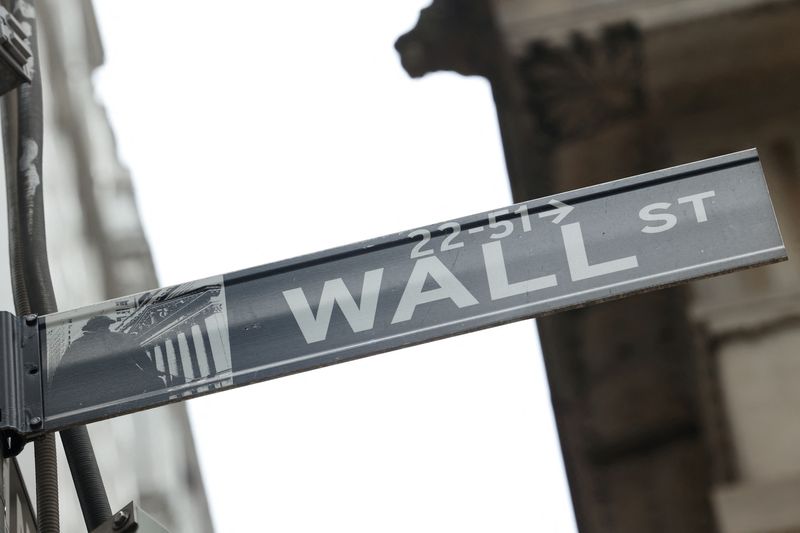Economy
Relentless U.S. stock rally faces Fed test


© Reuters. FILE PHOTO: A street sign marks Wall Street outside the New York Stock Exchange (NYSE) in New York City, where markets roiled after Russia continues to attack Ukraine, in New York, U.S., February 24, 2022. REUTERS/Caitlin Ochs/File Photo
By David Randall
NEW YORK (Reuters) – A U.S. stocks rally faces a potential inflection point next week as the Federal Reserve is expected to deliver what may be the final rate hike of its most aggressive monetary policy tightening cycle in decades.
As the year began, many investors expected higher interest rates to bring on a recession that would further hurt stocks after 2022’s sharp decline. Instead, the U.S. economy is proving resilient even as the Fed has made progress in its inflation fight – an ideal “Goldilocks scenario” that many believe will support equities. The is up nearly 19% year-to-date and closed on Thursday at 4,534.87, only about 6% below an all-time high reached in January 2022.
While investors broadly anticipate the central bank will raise rates by 25 basis points at its July 26 meeting, many also hope for signs that policymakers are more confident inflation will continue cooling, eliminating the need for the Fed to lift borrowing costs much further and supporting the thesis that has helped buoy stocks in recent weeks.
“A big part of the market is still macro driven and inflation is still in the driver’s seat. What the Fed does and says next week will be critical,” said Cliff Corso, chief investment officer at Advisors Asset Management.
Expectations of a benign macroeconomic backdrop and an end to Fed tightening have pushed some analysts to revise views on how high stocks will go this year.
Jonathan Golub of Credit Suisse on Tuesday raised his year-end target on the S&P 500 to 4,700 from 4,050, citing a stronger economic outlook and expectations of strong technology and communication service earnings.
Fundstrat Global Advisors’ Tom Lee raised his year-end target to 4,825 earlier this month, while Ed Yardeni of Yardeni Research sees the S&P 500 at 5,400 in the next 18 months.
Meanwhile, a gauge tracked by the National Association of Active Investment Managers showed stock pickers’ exposure to equities at its highest since November 2021, months before the Fed began its rate hiking cycle.
“Bearish investors have had to capitulate,” said Liz Ann Sonders, chief investment strategist at Charles Schwab (NYSE:). “We’re seeing a fundamental backdrop of lower inflation, resilient economic data, better consumer confidence, and a falling dollar that’s a pretty good recipe for gains.”
Eric Freedman, chief investment officer at U.S. Bank Wealth Management, has increased his stock holdings in recent months and is growing more bullish on the tech sector in anticipation that companies’ earnings will improve as the economy remains resilient.
“Consumers have been aided by a tight jobs market and some solid real wage gains, and at the same time we’re seeing some real progress on the inflation front,” he said.
At the same time, forecasts for a recession – seen as all but a foregone conclusion at the beginning of the year – are growing less dire.
Goldman Sachs (NYSE:) on Monday cut its probability of a U.S recession starting in the next 12 months to 20% from an earlier 25% forecast, positing that easing inflation could open a path for the Fed to lower rates without precipitating a downturn. The bank last month raised its year-end S&P 500 target to 4,500, from 4,000.
Yet many strategists remain bearish, wary of shortfalls during the ongoing earnings season to surprises in the durability of inflation.
Sunitha Thomas, senior portfolio manager at Northern Trust (NASDAQ:), believes inflation will prove more stubborn than expected and has cut exposure to equities in recent months.
“We’ve been telling clients that the market has had a very good run for some very good reasons, but now it’s a good time to rebalance,” she said.
Rising valuations have been another concern, with the S&P 500 now trading at 20.8 times forward earnings, from around 16 times at the start of the year.
However, Christopher Tsai, chief investment officer at Tsai Capital, is not worried about buying into an overvalued market. He has added eight companies to his portfolio this year, including index provider MSCI Inc and animal health company Zoetis Inc (NYSE:), that he believes have been overlooked in the market’s advance.
“It’s hard to find names that are massively overvalued,” he said.
Economy
Russian central bank says it needs months to make sure CPI falling before rate cuts -RBC


© Reuters. Russian Central Bank Governor Elvira Nabiullina attends a news conference in Moscow, Russia June 14, 2019. REUTERS/Shamil Zhumatov/File Photo
MOSCOW (Reuters) – Russia’s central bank will need two to three months to make sure that inflation is steadily declining before taking any decision on interest rate cuts, the bank’s governor Elvira Nabiullina told RBC media on Sunday.
The central bank raised its key interest rate by 100 basis points to 16% earlier in December, hiking for the fifth consecutive meeting in response to stubborn inflation, and suggested that its tightening cycle was nearly over.
Nabiullina said it was not yet clear when exactly the regulator would start cutting rates, however.
“We really need to make sure that inflation is steadily decreasing, that these are not one-off factors that can affect the rate of price growth in a particular month,” she said.
Nabiullina said the bank was taking into account a wide range of indicators but primarily those that “characterize the stability of inflation”.
“This will take two or three months or more – it depends on how much the wide range of indicators that characterize sustainable inflation declines,” she said.
The bank will next convene to set its benchmark rate on Feb. 16.
The governor also said the bank should have started monetary policy tightening earlier than in July, when it embarked on the rate-hiking cycle.
Economy
China identifies second set of projects in $140 billion spending plan


© Reuters. FILE PHOTO: Workers walk past an under-construction area with completed office towers in the background, in Shenzhen’s Qianhai new district, Guangdong province, China August 25, 2023. REUTERS/David Kirton/File Photo
SHANGHAI (Reuters) – China’s top planning body said on Saturday it had identified a second batch of public investment projects, including flood control and disaster relief programmes, under a bond issuance and investment plan announced in October to boost the economy.
With the latest tranche, China has now earmarked more than 800 billion yuan of its 1 trillion yuan ($140 billion) in additional government bond issuance in the fourth quarter, as it focuses on fiscal steps to shore up the flagging economy.
The National Development and Reform Commission (NDRC) said in a statement on Saturday it had identified 9,600 projects with planned investment of more than 560 billion yuan.
China’s economy, the world’s second largest, is struggling to regain its footing post-COVID-19 as policymakers grapple with tepid consumer demand, weak exports, falling foreign investment and a deepening real estate crisis.
The 1 trillion yuan in additional bond issuance will widen China’s 2023 budget deficit ratio to around 3.8 percent from 3 percent, the state-run Xinhua news agency has said.
“Construction of the projects will improve China’s flood control system, emergency response mechanism and disaster relief capabilities, and better protect people’s lives and property, so it is very significant,” the NDRC said.
The agency said it will coordinate with other government bodies to make sure that funds are allocated speedily for investment and that high standards of quality are maintained in project construction.
($1 = 7.1315 renminbi)
Economy
Russian central bank says it needs months to make sure CPI falling before rate cuts -RBC


© Reuters. Russian Central Bank Governor Elvira Nabiullina attends a news conference in Moscow, Russia June 14, 2019. REUTERS/Shamil Zhumatov/File Photo
MOSCOW (Reuters) – Russia’s central bank will need two to three months to make sure that inflation is steadily declining before taking any decision on interest rate cuts, the bank’s governor Elvira Nabiullina told RBC media on Sunday.
The central bank raised its key interest rate by 100 basis points to 16% earlier in December, hiking for the fifth consecutive meeting in response to stubborn inflation, and suggested that its tightening cycle was nearly over.
Nabiullina said it was not yet clear when exactly the regulator would start cutting rates, however.
“We really need to make sure that inflation is steadily decreasing, that these are not one-off factors that can affect the rate of price growth in a particular month,” she said.
Nabiullina said the bank was taking into account a wide range of indicators but primarily those that “characterize the stability of inflation”.
“This will take two or three months or more – it depends on how much the wide range of indicators that characterize sustainable inflation declines,” she said.
The bank will next convene to set its benchmark rate on Feb. 16.
The governor also said the bank should have started monetary policy tightening earlier than in July, when it embarked on the rate-hiking cycle.

 Forex3 years ago
Forex3 years agoForex Today: the dollar is gaining strength amid gloomy sentiment at the start of the Fed’s week

 Forex3 years ago
Forex3 years agoUnbiased review of Pocket Option broker

 Forex3 years ago
Forex3 years agoDollar to pound sterling exchange rate today: Pound plummeted to its lowest since 1985

 Forex3 years ago
Forex3 years agoHow is the Australian dollar doing today?

 Cryptocurrency3 years ago
Cryptocurrency3 years agoWhat happened in the crypto market – current events today

 World3 years ago
World3 years agoWhy are modern video games an art form?

 Commodities3 years ago
Commodities3 years agoCopper continues to fall in price on expectations of lower demand in China

 Economy3 years ago
Economy3 years agoCrude oil tankers double in price due to EU anti-Russian sanctions





















